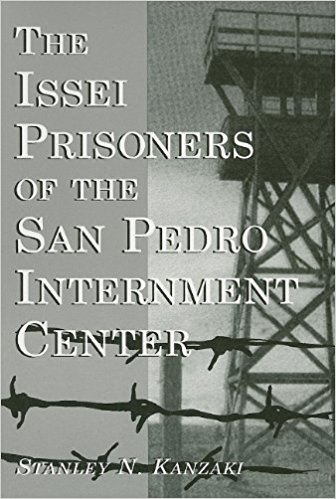The Issei Prisoners of the San Pedro Internment Center (book)
Creators: Stanley N. Kanzaki
Novel by Stanley N. Kanzaki about Issei internees at the fictional San Pedro Internment Camp in New Mexico.
The protagonist is Kenji Yamato, a young Issei leader from the San Francisco Bay Area. After a brief opening chapter that sees the dazed internees arriving at the San Pedro camp, the first half of the book consists of a flashback detailing Kenji's charmed life to that point. The son of Japanese diplomats, he is raised in San Francisco and goes on to the University of California where he grows close to a pair of professors, Robert and Nona Moore. His studies take him around the world, and he has colorful adventures crossing the U.S. and then the Atlantic to study at Oxford, then across Europe and Asia to take a position teaching English at Tokyo University. Dismayed by the growing regimentation and militarism in Tokyo, he accepts a research position with the Moores back the University of California, where he finishes his Ph.D. He takes a job at a Japanese bookstore in San Francisco and gets involved with the UC Nisei Club, where he becomes romantically involved with Sumiko Matsuno, the daughter of a rival bookstore owner. He later is hired by the Bank of America, the first Issei to land such a position and quickly takes on leadership positions in the Japanese Association and other immigrant organizations.
With the attack on Pearl Harbor, Kenji is among the first to be arrested. The second half of the novel is set in the San Pedro Internment Camp, which is seemingly based on the Lordsburg , New Mexico, camp. Camp administrators, led by the corpulent drunkard Captain Donald E. Trolls, are portrayed as cruel and corrupt, the implication being that any capable soldiers had been deployed in battle, leaving only the rejects to run internment camps. The Issei organize themselves and select Kenji as their leader given his English language abilities. Despite the conditions, they do their best to improve conditions under the leadership of Kenji; Rev. Ishida, a San Francisco-based Buddhist priest; and Shozo Kojimoto, a landscape architect and judo instructor. After a brief period of hope when a competent and compassionate wounded veteran takes over the camp, conditions deteriorate further when he is sent back to the battlefield. The men battle ennui and demoralization as the war comes to a close. The novel ends with a 25th anniversary reunion in San Francisco that reveals the surprising turns some of their lives had taken.
Author Stanley N. Kanzaki is a Nisei who was incarcerated at Tanforan and Topaz as a child and was raised in New York City after the war. After a stint in the army, he went on to a career as a social worker in New York. In an introductory "Notes" section, Kanzaki writes that he based the novel on various unspecified readings and on conversations with Issei.
While the events depicted are plausible, there are a couple of instances where the author takes some dramatic license. On Kenji's journey to the U.S. from Japan in the mid 1930s, he describes his interactions with immigrants and picture brides on their way to the U.S. But all immigration had been cut off by the Immigration Act of 1924 and the migration of picture brides had been ended prior to that. Later, at the 25th anniversary reunion (which could have taken place no later than 1970), Rev. Ishida mentions the existence of a class-action lawsuit over the incarceration; while such a lawsuit did take place, it was not filed until 1983.
Find in the Digital Library of Japanese American Incarceration
The Issei Prisoners of the San Pedro Internment Center
This item has been made freely available in the Digital Library of Japanese American Incarceration , a collaborative project with Internet Archive .
Might also like:
Upon Their Shoulders
by Shelley Ayame Nishimura Ota;
What the Scarecrow Said
by Stuart David Ikeda;
Two Homelands
by Toyoko Yamasaki
| Author | Stanley N. Kanzaki |
|---|---|
| Pages | 270 |
| Publication Date | 2009 |
